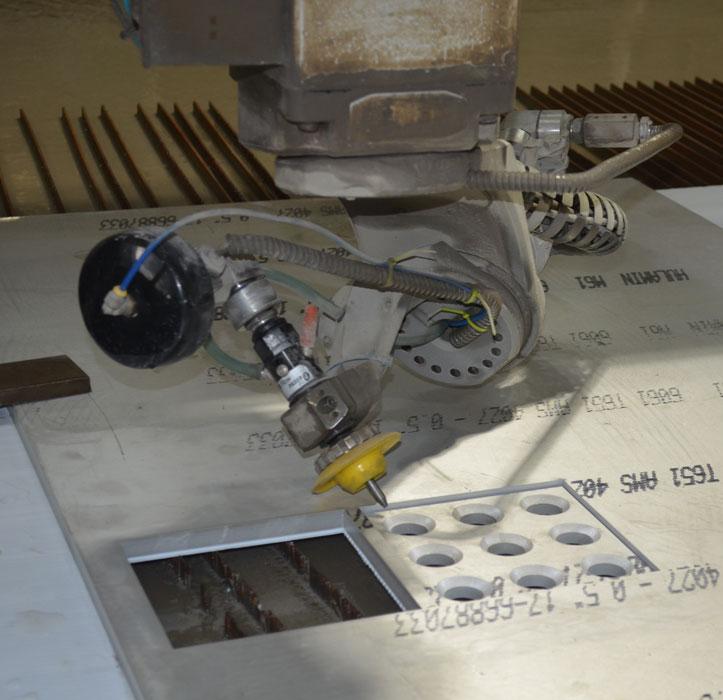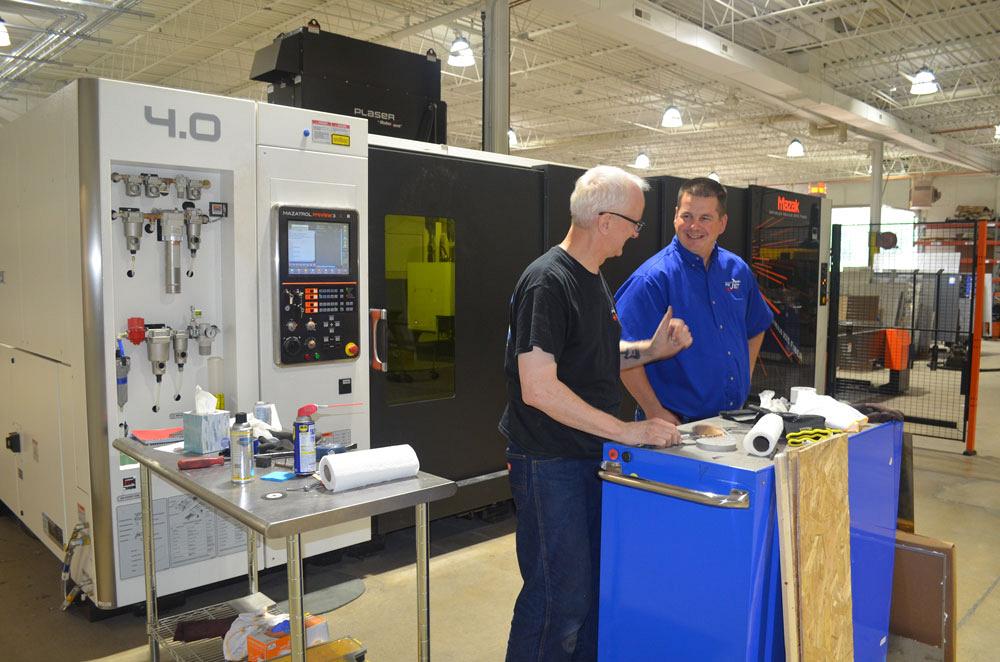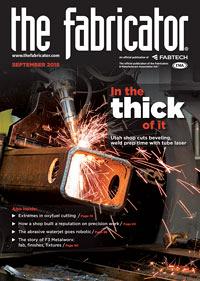Editor-in-Chief
- FMA
- The Fabricator
- FABTECH
- Canadian Metalworking
Categories
- Additive Manufacturing
- Aluminum Welding
- Arc Welding
- Assembly and Joining
- Automation and Robotics
- Bending and Forming
- Consumables
- Cutting and Weld Prep
- Electric Vehicles
- En Español
- Finishing
- Hydroforming
- Laser Cutting
- Laser Welding
- Machining
- Manufacturing Software
- Materials Handling
- Metals/Materials
- Oxyfuel Cutting
- Plasma Cutting
- Power Tools
- Punching and Other Holemaking
- Roll Forming
- Safety
- Sawing
- Shearing
- Shop Management
- Testing and Measuring
- Tube and Pipe Fabrication
- Tube and Pipe Production
- Waterjet Cutting
Industry Directory
Webcasts
Podcasts
FAB 40
Advertise
Subscribe
Account Login
Search
High-precision cutting in part fabrication
Shop builds its reputation and business on high-tolerance work
- By Dan Davis
- August 28, 2018
- Article
- Waterjet Cutting

Figure 1
A banner above Precision Waterjet’s shop floor reminds guests of the power that waterjets can deliver as they are cutting high-precision metal parts.
Waterjet cutting caught Rich Edwards’ eyes at a trade show in 2005, and he couldn’t shake the idea that maybe he could make a living with waterjets.
Back then he was working in the corporate research and development lab for a Chicago-area manufacturer, fabricating prototypes, running CNC mills and lathes, and working with shops to ensure that they could build parts his company needed. He was basically taking engineers’ ideas and translating them into the real world of manufacturability. Edwards, who had been trained as an aircraft mechanic, left that career because he wanted to create, not just follow repair procedures. This waterjet idea looked like it could be an outlet for him to foster his problem-solving ability and unleash the creative side of his brain.
During this time, his son was born prematurely, so he was spending a lot of time at the hospital. Idle time is not good for a person with an active mind, and Edwards kept thinking about waterjet cutting and the niche he saw his business occupying: high-tolerance cutting.
“That’s what sold me,” Edwards recalled. “All of these guys were making parts on the waterjet, just roughing them out and cutting the fat off. But they were then putting them on a mill and finishing them off to ± 0.005 inch. Why were they doing that?
“I thought I could run a mill and make those same parts. I thought I could do it on a waterjet too. That was the idea,” he added.
Edwards approached his father, Larry, with the idea in 2006, and he liked what he heard. They both mortgaged their houses, and Rich bought a 50-HP, 60,000-PSI Flow IFB 6012 waterjet. Precision Waterjet in Cary, Ill., was open for business (see Figure 1).
That’s when Edwards hit the road, knocking on doors and sharing his vision of metal fabrication. Precision Waterjet was slightly more expensive, but it was going to deliver a final part, which wouldn’t need to be placed on a mill to be finished to specifications. The fabricator was going to help its customers to reduce their machining costs and speed up their own production efforts because they weren’t going to be waiting on secondary finishing processes to be completed for their high-precision parts.
Jetting Ahead
The Great Recession in 2008 was a major bump in the road for Precision Waterjet. (“I asked what the hell were we doing back then,” Edwards joked.) But the new waterjet shop hung on and remained committed to its strategy, which other companies in the area began to take notice.
The strategy has helped the shop to grow into a 13-person, two-shift fabricating operation. It moved into a 14,000-square-foot facility in Crystal Lake, Ill., in 2017 to accommodate more work.
In those years before to the company’s relocation, Edwards said the focus was on building a team that problem-solved like him and had a mechanical curiosity about what the waterjet was capable of doing. Years of holding leadership, design, manufacturing, and even janitorial roles left Edwards knowing that he couldn’t do it all. He needed to have individuals trained to approach the business as he would. They weren’t necessarily clones, but they couldn’t think like other area fabricators. There was a reason those shops weren’t winning the jobs that Precision Waterjet was building its reputation on.

Figure 2
The company’s Flow Mach 4 4030 waterjet has a cutting head capable of delivering bevel cuts up to 45 degrees.
“The main reason they didn’t do this work is because it’s hard,” Edwards said. “Waterjets are not machines that will consistently produce ±0.005 in. throughout the years if you don’t have the proper fixturing and follow a maintenance schedule.”
Precision Waterjet also added another waterjet to the mix. In 2012 it purchased a 100-HP, 94,000-PSI Flow Mach 4 4030 waterjet, which had a cutting head that could cut at an angle (see Figure 2). Edwards said, with the increased horsepower and pressure, the waterjet can cut 1.5 to 1.7 times faster than its original table.
As Edwards said, however, equipment can only do so much in keeping customers happy with on-time delivery of parts that meet their specifications. Precision Waterjet knows what it takes to meet the high expectations associated with high-tolerance parts.
Knowing the Machine. Over 10 years of cutting metal and other material on a waterjet, Edwards and the Precision Waterjet team have come up with several tips and tricks to get the most out of the machine. For instance, they know what orifices work best for certain applications and how they can tune cutting heads to deliver a specific cut.
Also if you happen to be familiar with waterjet cutting equipment and you look inside the shop’s waterjets, you’ll notice that those tables aren’t the factory-supplied tables. Precision Waterjet designs and makes its own tables. The focus of the design is on modularity, so an operator can remove a small section for replacement, not large sections. This allows for quick changeovers of slats and minimal downtime.
Knowing Fixturing. It’s not something they teach in engineering school, but after you have worked with machining centers, you develop a good feel for setting up parts in a mill for high-tolerance work. That was always in the back of Edwards’ mind as he set up his business.
He describes a fixture that he designed for a racecar clutch for one of the company’s original customers. The fixture that holds the circular parts fits snuggly in the tank and doesn’t move during waterjet cutting.
“It runs all day and doesn’t move more than 0.001 in. during the day,” Edwards said.
The previous fabricator that was fabricating the clutches was scrapping 50 percent of the parts because it couldn’t hit the tight tolerances. Edwards said that they were able to cut that down to 1 percent, which was mostly related to dialing in the waterjet on the first part of the run. The waterjet operators did most of the fine tuning using aluminum blanks before cutting the race car clutches, which helped to keep the scrap rate low on the project.
Edwards also points out that he ended up selling six of his own fixtures to the U.S. Army, which needed them for bevel cutting. This was in the days before the bevel cutting head technology was developed.

Figure 3
Rich Edwards, president of Precision Waterjet, talks with Craig Lothson about the job on the Mazak fiber laser cutting machine
Knowing Maintenance. Anyone knows that waterjets require a good bit of maintenance. Waterjet cutting is a violent process, and it takes a toll on the machinery parts.
Precision waterjet is religious about staying on top of maintenance schedules, replacing all worn parts on a regular basis. It’s one of the reasons that the company has gotten more than 18,000 hours of production from its original waterjet. Well, that’s what the hour meter read before it officially died in 2017.
Edwards said that the machine has been through five sets of ball screws and countless pumps.
“A lot of companies will keep a waterjet running, but they won’t keep it running for high-precision work. If it can move along the X and Y, they think it’s good,” Edwards said.
Knowing the Shop Floor Knows What You Know. Edwards has worked hard to share his knowledge with his shop floor co-workers. It’s the best way that he knows to spread the mindset that has helped to build the company.
That means that all jobs are held to tight tolerances. That may sound like overkill, but it works for Precision Waterjet.
“I still have my guys focusing on tight tolerances, even if the tolerance is ±0.050. They are still dialing the machine in before the cut is made so that we can have test cuts that are ±0.001,” he said. “That way we know the parts are always going to be good.”
“That’s the way our business model runs. We always strive for perfection,” Edwards continued. “Everybody on the floor is getting the practice and developing the mindset. When those other jobs hit that require greater precision, it’s just second nature for them.”
A New Kind of Cutting
In the months before the move to Crystal Lake, Bill Kirkelie, Precision Waterjet’s sales manager, noticed that even as the business was growing, it was losing jobs that involved cutting copper, brass, and thin steel sheet. All of those jobs were going to shops with fiber laser cutting machines. Complicating matters was the fact that Precision Waterjet couldn’t find another fab shop with a fiber laser cutting capability that could meet its own turnaround demands.
“We couldn’t find a reliable source in the area that could deliver to our model of high-quality products in a fast manner,” Kirkelie said. “They could probably do it in six to eight weeks out, but my customers aren’t going to go for that. Our standard lead time is one to three weeks. We even deliver parts for some customers in hours.”
Edwards knew that he couldn’t speed up the waterjets to be competitive, so he started seriously considering a possible upgrade in cutting capability. He had been watching the fiber laser cutting technology since its debut in the late 2000s and thought it had matured to the point where such an investment wouldn’t be too much of a gamble. He did the same thing with the purchase of his second waterjet, waiting for a couple of years while the tilting cutting heads proved themselves in the marketplace.
Around the beginning of 2017, a neighbor of Precision Waterjet’s from the old industrial park in Cary helped Edwards see the laser light. The company’s owner was looking to retire and sought Edwards out as a potential buyer. The potential takeover business also fabricated high-tolerance parts like Precision Waterjet and shared many of the same customers, but it specialized in laser cutting work. It looked like a nice fit for Precision Waterjet, Edwards said, especially with the hiring of a 20-year veteran of laser cutting, who came with the acquisition of an almost 20-year-old CO2 laser cutting machine.
That acquisition cemented the shop’s near-term growth. It was going to be laser cutting.
In early 2017 Precision Waterjet doubled-down on its initial bet. It installed a Mazak Nexus 3015 4-kW fiber, which not only cuts reflective metals such as brass and copper, but also 0.75-in. mild steel (see Figure 3).
“We’re getting great parts off that machine,” Edwards said, after roughly six months of using the machine. “We get gorgeous cut edges. It’s all because of our laser cutting operators.”
Edwards said that he’s “more of a waterjet guy,” but he’s learning more about the technology. When asked about tabbing of smaller parts, he said it comes down to knowing where the tabs can be put. In short, it’s about customer conversations, which is the same way the company would approach relationships on the waterjet side of things.
But Edwards has had some influence on the laser cutting operation already. As with the waterjet tables, he has modified the stock table for fixture work. He also has added an extension to the laser cutting machine to accommodate sheet sizes that are longer than the typical 10 feet.
Gearing Up for Future Opportunities
The technology is in place to maximize future business opportunities, but Edwards said he’s still working on the personnel side of it. Hiring the right individual is a lot harder than holding a ±0.005-in. bevel on a steel tube in a waterjet. Experienced workers often come with bad habits, and others with some background in manufacturing just aren’t reliable, according to Edwards.
“We found the best thing is that we hire some people with some type of mechanical background, but it doesn’t have to be waterjet or laser cutting,” he said. “We actually have had our best luck with people who’ve never touched a machine before in their life. In fact, some of my best operators out there never touched a machine before they came to work here.”
The goal is to develop shop floor talent that can do multiple jobs willingly and learn how things are fabricated. Basically, Edwards wants a shop full of people that approach the business as he does—someone who knows the how the business runs, from the front office to the shipping department, and who does what is necessary to get orders out the door on-time and exceeding quality specifications.
Precision Waterjet has grown by four workers over the past couple of years. Those hires have been instrumental in getting the company’s second shift going recently. Edwards said he’s still looking for “honest” individuals to add to the work force.
Now that he’s no longer working 100 hours per week, Edwards is spending more time mentoring employees and doing design work. One recent project had him redesigning a telescoping ramp that a customer uses to board train cars for maintenance work. Edwards got permission to trash the original designs and came up with a new design that can hold up to 500 pounds. The customer loved it, and Precision Waterjet gets to cut all of the pieces.
“That’s the kind of thing that we can do as we grow with our customers,” Edwards said.
Edward once saw an opportunity with waterjets where others didn’t. His current outlook appears to be pretty solid as well.
Precision Waterjet Inc., www.pwjet.com
Flow Waterjet, www.flowwaterjet.com
Mazak Optonics Corp., www.mazakoptonics.com
About the Author

Dan Davis
2135 Point Blvd.
Elgin, IL 60123
815-227-8281
Dan Davis is editor-in-chief of The Fabricator, the industry's most widely circulated metal fabricating magazine, and its sister publications, The Tube & Pipe Journal and The Welder. He has been with the publications since April 2002.
Related Companies
subscribe now

The Fabricator is North America's leading magazine for the metal forming and fabricating industry. The magazine delivers the news, technical articles, and case histories that enable fabricators to do their jobs more efficiently. The Fabricator has served the industry since 1970.
start your free subscription- Stay connected from anywhere

Easily access valuable industry resources now with full access to the digital edition of The Fabricator.

Easily access valuable industry resources now with full access to the digital edition of The Welder.

Easily access valuable industry resources now with full access to the digital edition of The Tube and Pipe Journal.
- Podcasting
- Podcast:
- The Fabricator Podcast
- Published:
- 04/16/2024
- Running Time:
- 63:29
In this episode of The Fabricator Podcast, Caleb Chamberlain, co-founder and CEO of OSH Cut, discusses his company’s...
- Trending Articles
Tips for creating sheet metal tubes with perforations

JM Steel triples capacity for solar energy projects at Pennsylvania facility

Are two heads better than one in fiber laser cutting?

Supporting the metal fabricating industry through FMA

Omco Solar opens second Alabama manufacturing facility

- Industry Events
16th Annual Safety Conference
- April 30 - May 1, 2024
- Elgin,
Pipe and Tube Conference
- May 21 - 22, 2024
- Omaha, NE
World-Class Roll Forming Workshop
- June 5 - 6, 2024
- Louisville, KY
Advanced Laser Application Workshop
- June 25 - 27, 2024
- Novi, MI


























